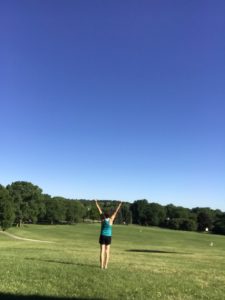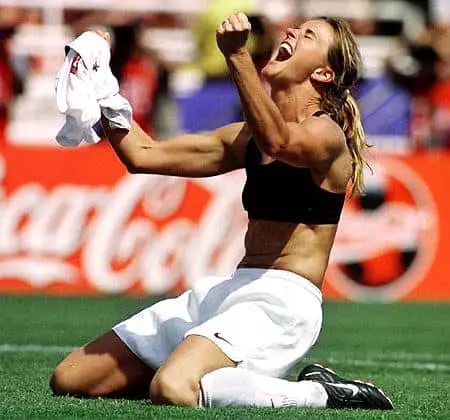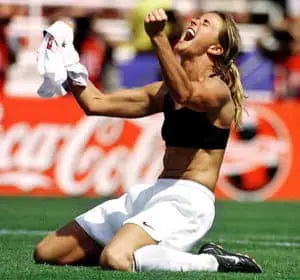Table of Contents
*This post may contain affiliate links. As an Amazon Associate we earn from qualifying purchases.
We all communicate, whether we are talking or not. This means your body posture is constantly “talking” to yourself and others. In fact, our “nonverbals” communicate more to other people than our words. Nonverbal communication includes such things as eye contact, distance between people when talking, touch and gestures. In addition, nonverbal communication also includes our body language and body posture.
Have you ever looked at a person, and without talking to her, made some assumptions about this person based on her body stance? Every coach, athlete or executive “sizes up” people and makes split-second decisions based on these impressions. But a bigger question to consider is how does your own body language affect your own performance?
What Your Body Language Communicates to Yourself
I often ask athletes and others in high performance situations about where in their body they feel the sense of confidence. I will even ask them to point to where in their body they feel confidence. The answers have varied from feeling it in one’s belly, or shoulders, or back or legs. Pause for a moment and ask yourself this question: When you feel confident and strong where does that feeling live in your body? And when you have this sense of confidence how do you walk, what is your posture like and how might others know you feel this way by just looking at you?
Professor Cuddy of Harvard has studied the effect that body language and posture has on hormones in our bodies. Her finding indicate that confident people tend to respond to stress, while less powerful people tend to react to stress with more stress. This is a subtle, but very important difference. This can be measured through two hormones in the body: testosterone and cortisol.
- Testosterone is a regulator of physical energy and the ability to think clearly
- Cortisol is released in response to stress and it helps generate new energy from stored reserves.
Here is how this works:
Powerful and confident people have more elevated levels of testosterone and lower levels of cortisol. But those feeling less powerful or confident tend to have higher levels of cortisol.
Thus, high performing athletes have elevated levels of testosterone and lower levels of cortisol. These hormones are associated with performing better.
Change How You Feel By Changing Your Posture
“Power posing” is a term used by Amy Cuddy, a professor and researcher at Harvard Business School. This pose consists of standing tall with your arms raised and open wide into a v shape above the head. Also have a slightly turned up of the chin and make your eyes look up to the sky. This is a power pose. It is also considered the universal body posture of victory. Professor Cuddy has been researching how this posture affects how an individual feels while doing this and how this posture can benefit people in real life competitive situations.
“Our bodies change our mind, and our minds can change our behavior, and our behavior can change our outcomes,” explains Professor Cuddy. This concept can be very valuable for an athlete from the perspective of outcome-based performance. When athletes are in the face of competition, how they handle and respond to pressure can make or break a performance. This is where the simple practice of power posing can change the game. If you get pulled from the game do you sit on the bench with your head and shoulders down? Or prior to a competition do you spend a few minutes in the power pose and boost your hormones to support you in competition? You can purposely choose how to manage your body posture in these situations as another tool to get your ready or keep you alert in competition.
Power Posing: What can you?
 Stand for a few seconds in a power pose (see the picture to the left). Ideally, power posing is done every day.
Stand for a few seconds in a power pose (see the picture to the left). Ideally, power posing is done every day.
Prior to a competition, stand and breathe for a minute or two in a power pose as part of a pre-competition routine.
If sitting on the bench and trying to stay mentally in the game make sure to purposely stretch up or open your body posture to have a minute of power posing in some way.
You can also do this activity for other situations. For example:
- Before a test
- Before a job interview
- Before a public speaking event
- Before a big meeting
What Is Your Body Language and Posture Telling Others
Remember, as stated earlier body language is a form of non-verbal communication both to others and to yourself. For example, when an athlete is competing, there is a steady stream of information being shared through body postures and actions. Athletes size up one another and look for subtle non-verbal cues that say things like “I am confident” or “I am scared”. There are moments when athletes let their guard down and show disappointment or frustration.
Interestingly, in 2012 researchers Furley, Dicks, and Memmert studied body language of soccer players. They found that penalty takers with submissive body language were thought be less confident and more anxious as compared to those with dominant or power type body language.
If you are paying attention, as an athlete, that is a cue that you can out-perform your competition by using your mental awareness and focus. When you notice someone in a non power pose stance this is your moment to let your talent, skill and practice to pay off. It’s your time to turn up the heat on your opponent.This is using your power of good awareness to your advantage.
You know who else watches body language besides your opponent? YOUR COACH (or boss). Those in position of authority often look at how their team members respond to adversity. They might even set up situations on purpose to see who handles pressure and who does not. Exasperated looks, slumped body posture and a defeated look all communicate. So, if you need to work on recovering from mistakes better or faster, than practice changing your body language on purpose for this reason. It is a tool that can be very helpful.
Power Posing and Body Language Awareness
Coaches and others might be wise to teach athletes and those they work with to have more awareness of their body language. Since you and your opponents are impacted by your body stance and posture this only makes sense. When not feeling confident learn to purposely change your body. Maybe this means “walking the walk.” Consider this to mean:
- Walk tall with confidence
- Have good eye contact and this means having your head neutral or with a slight tilt upwards
- Make your chest strong so you take up space
- Move your shoulders back
- And, if you can, raise your hands in the air
Without saying a word you are letting others know, and yourself know, you are ready for the task at hand.




